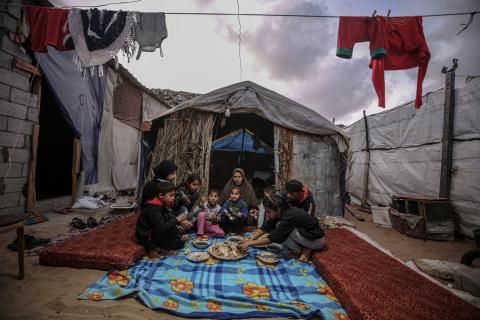Nutrition programming for school-age children and adolescents in humanitarian contexts
This is a summary of the following paper: Lelijveld N, Samnani A. & James P (2025). Towards a practical guide: A scoping review of nutrition programming, policy, and evidence for school-age children and adolescents in humanitarian contexts. https://doi.org/10.71744/6bcw-s147
The nutritional needs of school-age children (5-19 years) in humanitarian settings remain under-researched and poorly addressed, despite this phase being critical for growth, cognitive development, and long-term health. Emergencies exacerbate existing nutritional deficiencies, leading to conditions such as thinness/wasting, micronutrient deficiencies, and overweight/obesity. This report summarises current policies, programmes, and evidence on nutrition, health, and wellbeing for this age group in humanitarian contexts, drawing on literature reviews and expert interviews.
The report highlights the lack of nutrition data for school-age children and adolescents in both stable and emergency settings, making it difficult to assess nutritional status during emergencies. Global targets and indicators for this age group are already limited, leading to even greater invisibility in humanitarian response efforts.
Existing global policies acknowledge the importance of school-age and adolescent nutrition but often lack specific guidance for humanitarian contexts. Key policy documents include UNICEF’s ‘Core Commitments for Children’, WHO’s adolescent nutrition guidelines, and the multi-agency ‘Global Accelerated Action for the Health of Adolescents.’ Additionally, the Inter-Agency Standing Committee provides frameworks for engaging young people in crises.
Interviews with practitioners revealed a lack of nutrition interventions specifically targeting school-age children and adolescents in emergencies. Some broader programmes included adolescents incidentally, such as those for people living with HIV or pregnant and breastfeeding women. Other sector interventions, like sexual and reproductive health and education programmes, occasionally incorporated a nutrition component. The report highlights recommended nutrition interventions, including the provision of nutritious foods through school meals, staple food fortification, and general food distributions, with special attention on school-age children and adolescents. The management of wasting and thinness, micronutrient supplementation such as iron, folic acid, multiple micronutrients, and deworming, as well as nutrition education and physical activity promotion, are also emphasised. Efforts to create healthy food environments involve regulating vendors, marketing practices, and as well as cash and voucher assistance. Special support for pregnant and breastfeeding adolescent girls includes nutritional screening, supplementation, social assistance, and empowerment programmes.
Several barriers hinder effective nutrition programming for this age group in humanitarian contexts.
- Lack of data and indicators: malnutrition prevalence is not well documented, making advocacy and intervention planning difficult.
- Limited funding and policy focus: school-age children and adolescents are deprioritised in humanitarian funding and response plans.
- Inadequate assessment tools: MUAC (mid-upper arm circumference) and body mass index-for-age (BAZ) remain underutilised due to lack of standardised protocols.
- Weak integration across sectors: nutrition interventions for this age group must especially be embedded within different sectors, like the education, health, and protection sectors, for maximum impact.
The findings of this report can guide stakeholders in developing a more robust, practical, and sustainable approach to nutrition for this critical age group in emergencies.


